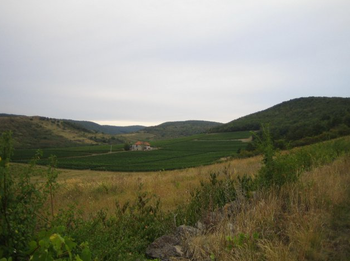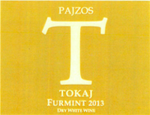
 |
| In times past, Hungarian Tokajis were among the most highly prized wines in the world. Long before Sauternes, they graced the tables of European elites and connoisseurs. In our era, at the outset of the privatization of the Tokaji region in the summer of 1991, the late Jean-Michael Arcaute and Jean-Louis Laborde led a group of wine lovers in the acquisition of Chateau Pajzos, long acknowledged as one of the finest vineyards of the region. Its 70 hectares of volcanic, rocky soils ensure that the native varieties - Furmint, Muscat, Harslevelu and Zeta – are both rich in natural acidity and concentration. They team carried out the first “private enterprise” harvest and vinification in 1991, thus launching the Renaissance of Tokaji. Today, Chateau Pajzos is under the sole ownership of the Laborde family, also the owners of Chateau Clinet in Pomerol. The estates are managed by Ronan Laborde and his winemaking team at Pajzos and Pomerol.
Located in the heart of the Tokaji region on slopes surrounding the famous wine village of Sarospatak, Chateau Pajzos "represents one of the world's great terroirs for producing exceptional white wines". The property's volcanic soils, ideal altitude of 200 meters, and South/South-West orientation rate its vineyards amongst the finest in Tokaj. Also, the vineyards' location between the Bodrog and Tisza rivers make it ideal for attaining noble rot, indispensible for making the finest sweet Aszu wines. The Tokaji wines are a blend of mostly Furmint, Hárslevelu ("linden's leaf"), Muscat de Lunel and Zéta. A base dry white wine is first made (Chateau Pajzos uses the Dry Furmint they produce), then mixed with Aszu berries (botrytised, shriveled grapes that were originally picked from bunches into 20 liter wooden tubs called puttony). During harvest, it can take up to 30 passages in the vineyards to pick them at the perfect time, as Chateau Pajzos only selects fully botrytised -not just passerille- grapes. Traditionally, the concentration of the Tokaji was defined by the number of puttony added to the base. Nowadays, the "Puttonyos" is based on the content of residual sugar in the final wine. It takes about 44 pounds of Azsu berries mixed with 100 liters of base wine to reach 1 Puttonyos. At Chateau Pajzos, the Tokaji are aged a minimum of 2 years in Hungarian oak (less than 20% new) and one year in bottle before release. They are only made in the best vintages. They are looking for freshness in their sweet wines, as opposed to other houses promoting a more oxidative style. |
| Chateau Pajzos Website |
 |
| Tokaji Furmint |
| Dry Furmint is unique to Hungary. There are just over 4000 ha planted in the world, 97% of which are in the Tokaj-Hegyalja region of Hungary. Although there are a few different theories, it’s widely accepted that Gouais Blanc is the original parent grape of the varietal. This variety was widely used in the Middle Ages and has been established as the parent as several more common varietals—specifically Riesling, Chardonnay, and Gamay. The estate’s volcanic, rocky soils ensure that Pazjos’ Furmint grapes are both rich in natural acidity and concentration. 100% Furmin. The bright, fresh and zesty flavors range from grapefruit to apricot with notes of nuts, minerals, and spice. The Furmint has aspects that remind one of Viognier, Pinot Gris, and Sauvignon Blanc, yet it is a unique wine. Its flavors are as appealing as they are original. |
 |
| H - Tokaji Late Harvest |
| Chateau Pajzos offers two, non-Aszu, single variety, wines. The Pajzos team has found that Harslevelu – one of the native varieties of the Tokaji region - is ideal when made as a Late Harvest wine, primarily due to its rich, full-bodied character, whereas Furmint excels as a dry and fruity white. The estate has 9 hectares of Harslevelu vines, 7 of which are more than 40 years old and formed part of the original, pre-privatization Pajzos vineyard. The “H” is made from overripe, raisined Harslevelu grapes picked mid-way through the harvest period at Pajzos. (The still riper fruit picked later is dedicated to the production of the Pajzos Aszu wines.) The Harslevelu late-harvest fruit is given a short maceration and is then gently pressed to extract the small quantity of juice in the grapes. The must ferments in stainless steel tanks for two weeks. The young wine is then racked and returned to stainless steel tanks for 8 months of aging at controlled, low temperature. It is racked off the solids two more times to ensure the freshness and purity of the fruit. The 2011 Chateau Pajzos “H” was bottled in June of 2012 with just over 100 grams per liter of residual sugar balanced by 5.7 grams per liter of acidity. 2011 was an ideal year for making a vivid late harvest Harslevelu wine due to the exceptionally dry conditions of the vintage. The complete lack of rain in the Tokaji region from August through October blocked the developed of botrytis and concentrated the juice while keeping acidity levels high. The Pajzos team picked their Harslevelu grapes for the “H” under sunny and dry conditions between October 18-25. (Humid conditions were to return in late October and into November, encouraging the development of botrytis for the Aszu wines of the year.) The 2011 Chateau Pazjos “H” is an intensely expressive, moderately sweet wine with bright and pure aromas and flavors of apricot, white-peach, lime and spice. They are balanced and lifted by vivid fruity acidity, the signature of the Pajzos terroir. |
 |
| Tokaji Aszu - 5 Puttonyos |
| Furmint, Muscat, Harslevelu. The grapes for the Aszu wines were hand-picked in October and November in several passes at an outstanding level of ripeness during sunny, hot and dry days and very cool nights. Pajzos’ Aszu 5 Puttonyos is aged for three years in 220 liter, Hungarian oak casks, of which 30% were new, followed by three more year in stainless steel tanks. It was then assembled, lightly filtered, and bottled in November. The stunning residual sugar level of 156 grams per liter qualifies the wine to be classified at a higher level, and it is balanced by more than 7 grams per liter of acidity. |
 |
| Aszú-Esszencia |
| 60% Furmint, 30 % Hárslevelű, 10 % Yellow Muscat.BR>2000 was an outstanding vintage in the Tokaj Wine Region with superb quality aszú berries, elegant acids and long aging potential. The aszú berries were harvested from the end of October until the end of November. Fermentation and aging in barrique oak barrels from the Zemplén hills for 3 years. Acidity 10 gr/l, residual sugar sugar 253 gr/l, alcohol 6,3 % vol. Aging potential 30 to 40 years. “The palate is unctuous on the entry with honey, molasses, ginger, Mirabelle and kumquat. Against expectations, it does not feel cloying in the mouth, with admirable purity and focus on the creme brûléee-infused finish. Very fine, very sexy and very more-ish.” Neil Martin, 93 points (2013). |
 |
| Muskotaly |
| From 100% Muscat Petit Grains, this unctuous wine is made with the same complex method as the Aszu wines - but it is not aged in oak. The late-harvest grapes for the blend are affected by the dual phenomena of botrytis and passerillage, which further concentrates the natural sugars. The Muskotaly is at the sweetness level of an Aszu-Esszencia, 192g/l of residual sugar, with 12 grams of acidity. This unique wine sees an early bottling to preserve the vivid, perfumed muscat fruit. |
| Copyright © 2002-2017 VOS Selections, Inc. |